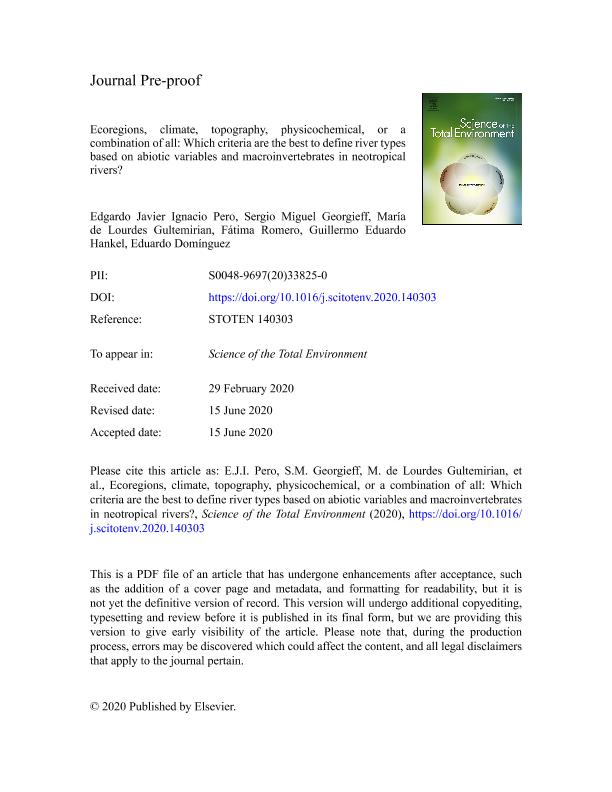Mostrar el registro sencillo del ítem
dc.contributor.author
Pero, Edgardo Javier Ignacio

dc.contributor.author
Georgieff, Sergio Miguel

dc.contributor.author
Gultemirian, Maria de Lourdes

dc.contributor.author
Romero, Fátima
dc.contributor.author
Hankel, Guillermo Eduardo

dc.contributor.author
Dominguez, Eduardo

dc.date.available
2021-11-09T13:04:27Z
dc.date.issued
2020-10-18
dc.identifier.citation
Pero, Edgardo Javier Ignacio; Georgieff, Sergio Miguel; Gultemirian, Maria de Lourdes; Romero, Fátima; Hankel, Guillermo Eduardo; et al.; Ecoregions, climate, topography, physicochemical, or a combination of all: Which criteria are the best to define river types based on abiotic variables and macroinvertebrates in neotropical rivers?; Elsevier Science; Science of the Total Environment; 738; 18-10-2020; 1-20
dc.identifier.issn
0048-9697
dc.identifier.uri
http://hdl.handle.net/11336/146410
dc.description.abstract
The baseline conditions for a particular river or stream type are essential to classify aquatic ecosystems based on physical and biological characteristics. In this study, we proposed a river typology for different ecoregions, climate and topography of northwestern Argentina using parameters, and combined key variables to establish reference conditions. A set of geographical, hydro-morphological, hydrological, geological (pedology and sedimentology) and physicochemical variables were measured from different rivers and analyzed with clustering and ordination techniques to develop a typology. We analyzed the correspondence of the physical river conditions and benthic macroinvertebrate assemblages using non-metric multidimensional scaling analysis, dissimilarity among assemblages, ANOSIM approach and envfit analysis in order to make an ecological validation of the classification. Our results allowed us to classify the neotropical rivers studied, according to typological systems adapted from the European Water Framework Directive. The combination of ecoregions and topography along with other variables associated (system B), was better corresponded with biological arrangements. Hence, ecoregions and topography combined turned out to be more precise as a criterion to define river types and their local abiotic and biotic reference conditions. Macroinvertebrate distribution corresponded with the classifications proposed and was related with abiotic features of the rivers. The physical variables as altitude, grain size, water temperature and turbidity were key parameters to develop a schematic model to define river types that could be implemented and tested in other countries of the region. Five river types have been identified, characterized, and included in three large groups: Mountains, Foothills, and Lowlands (Plains). Our results showed that topography and climate are two aspects that strongly influence South American freshwater biota. We propose the schematic model developed in our study as a baseline to define freshwater biomes based on altitude (topography), ecoregions (climate) and biological functional traits at a broad spatial scale (continental or global).
dc.format
application/pdf
dc.language.iso
eng
dc.publisher
Elsevier Science

dc.rights
info:eu-repo/semantics/openAccess
dc.rights.uri
https://creativecommons.org/licenses/by-nc-nd/2.5/ar/
dc.subject
CLASSIFICATION
dc.subject
FRESHWATER ECOSYSTEMS
dc.subject
LANDSCAPE
dc.subject
SOUTH AMERICA
dc.subject.classification
Biología Marina, Limnología

dc.subject.classification
Ciencias Biológicas

dc.subject.classification
CIENCIAS NATURALES Y EXACTAS

dc.title
Ecoregions, climate, topography, physicochemical, or a combination of all: Which criteria are the best to define river types based on abiotic variables and macroinvertebrates in neotropical rivers?
dc.type
info:eu-repo/semantics/article
dc.type
info:ar-repo/semantics/artículo
dc.type
info:eu-repo/semantics/publishedVersion
dc.date.updated
2021-08-25T19:29:24Z
dc.journal.volume
738
dc.journal.pagination
1-20
dc.journal.pais
Países Bajos

dc.journal.ciudad
Amsterdam
dc.description.fil
Fil: Pero, Edgardo Javier Ignacio. Consejo Nacional de Investigaciones Científicas y Técnicas. Centro Científico Tecnológico Conicet - Tucumán. Instituto de Biodiversidad Neotropical. Universidad Nacional de Tucumán. Facultad de Ciencias Naturales e Instituto Miguel Lillo. Instituto de Biodiversidad Neotropical. Instituto de Biodiversidad Neotropical; Argentina
dc.description.fil
Fil: Georgieff, Sergio Miguel. Consejo Nacional de Investigaciones Científicas y Técnicas. Centro Científico Tecnológico Conicet - Tucumán; Argentina. Universidad Nacional de Tucumán. Facultad de Ciencias Naturales e Instituto Miguel Lillo; Argentina
dc.description.fil
Fil: Gultemirian, Maria de Lourdes. Consejo Nacional de Investigaciones Científicas y Técnicas. Centro Científico Tecnológico Conicet - Tucumán. Instituto de Biodiversidad Neotropical. Universidad Nacional de Tucumán. Facultad de Ciencias Naturales e Instituto Miguel Lillo. Instituto de Biodiversidad Neotropical. Instituto de Biodiversidad Neotropical; Argentina
dc.description.fil
Fil: Romero, Fátima. Fundación Miguel Lillo; Argentina
dc.description.fil
Fil: Hankel, Guillermo Eduardo. Consejo Nacional de Investigaciones Científicas y Técnicas. Centro Científico Tecnológico Conicet - Tucumán. Instituto de Biodiversidad Neotropical. Universidad Nacional de Tucumán. Facultad de Ciencias Naturales e Instituto Miguel Lillo. Instituto de Biodiversidad Neotropical. Instituto de Biodiversidad Neotropical; Argentina
dc.description.fil
Fil: Dominguez, Eduardo. Consejo Nacional de Investigaciones Científicas y Técnicas. Centro Científico Tecnológico Conicet - Tucumán. Instituto de Biodiversidad Neotropical. Universidad Nacional de Tucumán. Facultad de Ciencias Naturales e Instituto Miguel Lillo. Instituto de Biodiversidad Neotropical. Instituto de Biodiversidad Neotropical; Argentina
dc.journal.title
Science of the Total Environment

dc.relation.alternativeid
info:eu-repo/semantics/altIdentifier/doi/https://doi.org/10.1016/j.scitotenv.2020.140303
dc.relation.alternativeid
info:eu-repo/semantics/altIdentifier/url/https://www.sciencedirect.com/science/article/abs/pii/S0048969720338250
Archivos asociados
